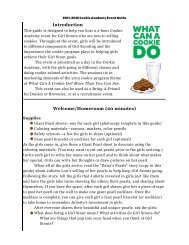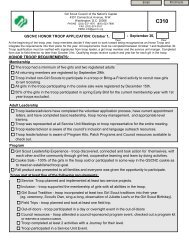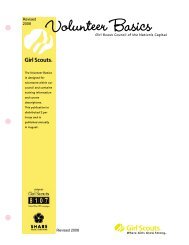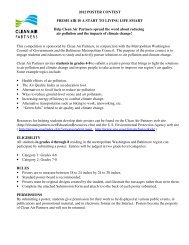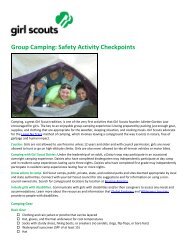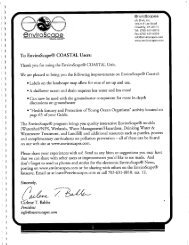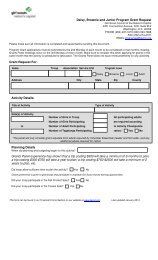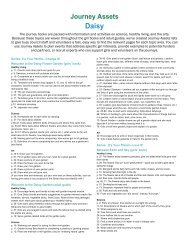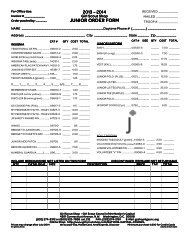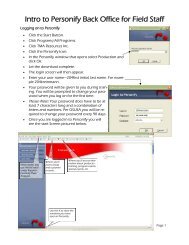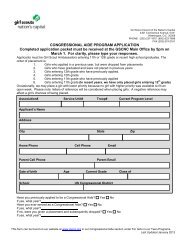Coles Trip Treasures Patch Program - Girl Scout Council of the ...
Coles Trip Treasures Patch Program - Girl Scout Council of the ...
Coles Trip Treasures Patch Program - Girl Scout Council of the ...
You also want an ePaper? Increase the reach of your titles
YUMPU automatically turns print PDFs into web optimized ePapers that Google loves.
<strong>Coles</strong> <strong>Trip</strong> <strong>Treasures</strong><br />
<strong>Patch</strong> <strong>Program</strong><br />
Activities for Brownie, Junior, Cadette, Senior and Studio 2B<br />
<strong>Girl</strong> <strong>Scout</strong>s to explore <strong>the</strong> unique assets <strong>of</strong> Camp <strong>Coles</strong> <strong>Trip</strong> and<br />
how <strong>the</strong>y relate to us and <strong>the</strong> Chesapeake Bay Watershed.<br />
<strong>Girl</strong> <strong>Scout</strong> <strong>Council</strong> <strong>of</strong> <strong>the</strong> Nation’s Capital<br />
4301 Connecticut Avenue, NW<br />
Washington, DC 20008<br />
202-237-1670<br />
800-523-7898<br />
www.gscnc.org<br />
This patch program has been made<br />
possible in part by a grant from <strong>the</strong><br />
Dillard Foundation and through<br />
family contributions to SHARE.<br />
<strong>Coles</strong> <strong>Trip</strong> <strong>Treasures</strong> August 2006 Page 1
Purpose<br />
<strong>Program</strong> Links<br />
This patch program is designed to be completed over<br />
<strong>the</strong> course <strong>of</strong> a weekend at Camp <strong>Coles</strong> <strong>Trip</strong>. Some<br />
activities can be completed at your campsite, while o<strong>the</strong>rs<br />
are meant to be done at specific camp locations. After<br />
participating in this patch program, girls should be able<br />
to<br />
• name three plants and three animals that inhabit<br />
Camp <strong>Coles</strong> <strong>Trip</strong><br />
• describe two key functions <strong>of</strong> wetlands and why<br />
wetlands are important for humans<br />
• describe how <strong>the</strong>ir actions at camp and at home<br />
affect wetlands<br />
• describe what an ecosystem is and what <strong>the</strong><br />
ecosystem at Camp <strong>Coles</strong> <strong>Trip</strong> looks like now<br />
or looked like at some point in history<br />
Brownie <strong>Girl</strong> <strong>Scout</strong>s: Earth & Sky, Eco-Explorer,<br />
Watching Wildlife, Water Everywhere, Listening to <strong>the</strong><br />
Past<br />
Junior <strong>Girl</strong> <strong>Scout</strong>s: On My Way, Traveler, Local Lore,<br />
Earth Connections, Outdoor Fun, Water Fun, Wildlife,<br />
Your Outdoor Surroundings, Rocks Rock, Water Wonders<br />
Teen <strong>Girl</strong> <strong>Scout</strong>s: All about Birds, Digging through <strong>the</strong><br />
Past, Eco-Action, From Shore to Sea, Plant Life, Wildlife,<br />
Camping IPs, Makin’ Waves Focus Book<br />
All ages: Roots and Shoots <strong>Council</strong>’s Own Try-It, badge<br />
and IP; Water Drop <strong>Patch</strong><br />
Compare this map <strong>of</strong> Camp <strong>Coles</strong> <strong>Trip</strong> in <strong>the</strong> 1970s to <strong>the</strong> one from 2006 on page 13.<br />
Page 2 August 2006 <strong>Coles</strong> <strong>Trip</strong> <strong>Treasures</strong>
Supply List<br />
Most activity supplies are available in a storage shed<br />
near <strong>the</strong> wetlands boardwalk. Be courteous to <strong>the</strong> needs<br />
<strong>of</strong> your fellow campers when doing any <strong>of</strong> <strong>the</strong>se activities:<br />
do not disturb o<strong>the</strong>r campers in <strong>the</strong>ir campsites, take<br />
only <strong>the</strong> patch program kit supplies you will need to<br />
complete your selected activities and discuss how to<br />
share supplies and locations equitably so everyone has<br />
a chance to fulfill <strong>the</strong> requirements.<br />
Activity Supplies Provided for 15 <strong>Girl</strong>s Supplies You Provide<br />
Wetlands Metaphors Laminated magazine photos, strainer, None<br />
sponge, antacid, egg beater, c<strong>of</strong>fee filter,<br />
cereal box, soap<br />
Water at Camp For each girl: cup, nylon, plastic tie,<br />
pencil, eyedropper; for everyone: food<br />
Soil to fill cup and 1<br />
bucket <strong>of</strong> tap water<br />
dye diluted in a cup<br />
Migration Headache 18 rubber bases None<br />
Tide Observation Board with paperclips on string, magnet, Shoes that can get wet<br />
4 dowel rods, long tape measure<br />
Water Absorption Stopwatch, 6 plastic drink bottles, 6<br />
funnels, 6 6” rulers, 6 laminated<br />
percolation charts, 6 calculators, 6<br />
c<strong>of</strong>fee tins w/ bottom cut out, 7 dry<br />
erase markers<br />
(optional)<br />
1 bucket filled with tap<br />
water for each team<br />
At Home at Camp Pencils, markers, clipboards Paper for each team<br />
<strong>Coles</strong> <strong>Trip</strong> Travel Pencils, markers for each girl<br />
Paper for each girl<br />
Agency<br />
Shrinking Habitat Green & blue construction paper, role<br />
nametags, 16 rope circles, 3-5 plastic<br />
tablecloths<br />
Situpons, chairs, tables<br />
Deadly Links 180 popsicle sticks (60 one size, 120<br />
ano<strong>the</strong>r size), 6 bandannas<br />
Mess kit bag for each<br />
player<br />
Camping Habits Copy <strong>of</strong> training guide for<br />
None<br />
Camping/Cookout<br />
Service Projects None Work gloves, trash bags<br />
Stair Comparison For each team: tape measure, protractor,<br />
weighted string, clipboard, laminated<br />
observation sheet, dry erase marker<br />
Paper<br />
<strong>Coles</strong> <strong>Trip</strong> Role Play<br />
Role play cards, situation sheet,<br />
topographic maps and transparencies<br />
with proposed nature center<br />
None<br />
Are You Me? Laminated animal cards None<br />
Optional Animal Dip nets, binoculars, insect nets, field Shoes that can get wet<br />
Observation<br />
guides, ice cube trays, jars, hand lenses<br />
Listening Activity None Notepad & pencil<br />
(optional)<br />
Log Investigation Field guides, hand lenses, bug boxes,<br />
index cards<br />
Flashlights<br />
<strong>Coles</strong> <strong>Trip</strong> <strong>Treasures</strong> August 2006 Page 3
Wetland Functions &<br />
Importance<br />
1. Discuss with girls<br />
<strong>the</strong> many functions <strong>of</strong><br />
wetlands. The<br />
Wetland Metaphors<br />
to <strong>the</strong> right represent<br />
<strong>the</strong> different functions<br />
if your girls need help<br />
guessing. 1<br />
2. Explore where our<br />
Water at Camp<br />
comes from by<br />
creating a model<br />
aquifer. This activity<br />
is described in <strong>the</strong> kit<br />
in <strong>the</strong> shed.<br />
3. Play Migration<br />
Headache on page 8.<br />
4. Do an experiment<br />
observing <strong>the</strong> tides<br />
(page 17) or water<br />
absorption for different soils (page 10).<br />
Requirements<br />
Brownie <strong>Girl</strong> <strong>Scout</strong>s: Do one activity from each <strong>of</strong> <strong>the</strong> four categories below.<br />
Junior <strong>Girl</strong> <strong>Scout</strong>s: Do one activity from each category below, plus one additional activity from any category.<br />
Cadette/Senior/Studio 2B <strong>Girl</strong> <strong>Scout</strong>s: Do one activity from each category below, plus two additional activities<br />
from any category.<br />
Before beginning activities, please complete <strong>the</strong> “Before” evaluation on page 20. Complete <strong>the</strong> “After” questions<br />
upon completion <strong>of</strong> activities.<br />
Wetland Metaphors<br />
sponge = absorbs excess water caused by<br />
run<strong>of</strong>f; retains moisture even after standing<br />
water dries up (sponge stays wet after it<br />
has absorbed a spill)<br />
pillow/bed = resting place for migratory birds<br />
egg beater = mixes nutrients and oxygen into<br />
<strong>the</strong> water<br />
cradle = provides a nursery that shelters,<br />
protects and feeds young wildlife<br />
strainer = strains silt and debris from water<br />
(keeps water supply clean)<br />
c<strong>of</strong>fee filter = filters smaller impurities from<br />
water (excess nutrients, toxins)<br />
antacid = neutralizes toxic substances<br />
cereal, rice, picture <strong>of</strong> garden = provides<br />
nutrient-rich foods for wildlife and humans<br />
soap = helps cleanse <strong>the</strong> environment<br />
picture <strong>of</strong> zoo = habitat for diverse wildlife<br />
picture <strong>of</strong> resort or motel = resting or<br />
wintering place for migrating waterfowl<br />
Ecosystems<br />
1. At Home at Camp – Discuss<br />
with girls <strong>the</strong> many plants and animals<br />
that make <strong>the</strong>ir homes at Camp <strong>Coles</strong><br />
<strong>Trip</strong>. In order for any plant or animal<br />
to make a place its home, <strong>the</strong> place<br />
must contain four things – food,<br />
water, shelter and space. Take some<br />
<strong>of</strong> <strong>the</strong> girls’ suggestions for animals<br />
that live at camp and identify<br />
specifically where at camp <strong>the</strong>se<br />
animals might find <strong>the</strong> food, water,<br />
shelter and space <strong>the</strong>y need. Have<br />
girls split into small groups, each<br />
selecting an animal (mosquito,<br />
raccoon, deer, etc.) and sketching <strong>the</strong><br />
four habitat elements where <strong>the</strong>y find<br />
<strong>the</strong>m at camp. 2<br />
2. Have girls pretend to be travel<br />
agents with <strong>the</strong> <strong>Coles</strong> <strong>Trip</strong> Time Travel<br />
Agency. Each should design a travel<br />
brochure, poster, radio or TV<br />
commercial for a fictional vacation<br />
package during a time period in <strong>the</strong><br />
history <strong>of</strong> Camp <strong>Coles</strong> <strong>Trip</strong>. <strong>Girl</strong>s can use whatever<br />
materials are appropriate and base <strong>the</strong>ir vacations<br />
on <strong>the</strong> history and photos <strong>of</strong> Camp <strong>Coles</strong> <strong>Trip</strong><br />
provided in this patch program booklet. If you are<br />
doing this activity before or after your trip to camp,<br />
encourage girls to refer to encyclopedias, history<br />
books, <strong>the</strong> Internet, former <strong>Coles</strong> <strong>Trip</strong> campers or<br />
o<strong>the</strong>r sources to find out more about <strong>the</strong> history <strong>of</strong><br />
<strong>the</strong> region around Camp <strong>Coles</strong> <strong>Trip</strong>. 3<br />
Photo: GSCNC Archive (photographer unknown)<br />
Camping in a platform tent at<br />
Camp <strong>Coles</strong> <strong>Trip</strong>.<br />
3. Play <strong>the</strong> Shrinking Habitat game (page 12) or <strong>the</strong><br />
Deadly Links game (page 18).<br />
Page 4 August 2006 <strong>Coles</strong> <strong>Trip</strong> <strong>Treasures</strong>
Requirements<br />
Actions at Home & at Camp Affect <strong>the</strong><br />
Environment<br />
1. Talk with <strong>the</strong> girls about <strong>the</strong> camping habits from<br />
your camp training that minimize impact on <strong>the</strong><br />
campground (i.e. staying on paths, running dish water<br />
through leaves in a bag, making a fire just big enough<br />
for cooking, using only fallen wood, etc.).<br />
2. Complete a service project at camp, such as trail<br />
maintenance, litter collection, wood stacking or<br />
scrubbing <strong>the</strong> lodges or boats. Contact <strong>the</strong> Camping<br />
Department for suggestions and guidelines prior to<br />
your visit.<br />
3. Compare several staircases throughout camp. The<br />
different designs all have <strong>the</strong> same goal: get people<br />
down or up a hill while minimizing <strong>the</strong>ir impact on<br />
<strong>the</strong> hill. Toge<strong>the</strong>r or as small groups, ask girls to<br />
observe <strong>the</strong> factors below. One group should also<br />
examine a steep hill that has a foot path instead <strong>of</strong> a<br />
staircase. After exploring <strong>the</strong>se questions, girls should<br />
compare <strong>the</strong>ir stair and footpath observations,<br />
discussing which staircase design seems to do <strong>the</strong><br />
best job <strong>of</strong> minimizing human impact on <strong>the</strong> hill.<br />
a. Estimate <strong>the</strong> steepness <strong>of</strong> <strong>the</strong> hill. Older girls can<br />
use <strong>the</strong> protractor, weighted string and tape<br />
measure to gauge steepness accurately.<br />
b. Do you walk on <strong>the</strong> hill itself or are you on a<br />
platform?<br />
c. Are <strong>the</strong>re plants on or near <strong>the</strong> stairs? Do areas<br />
with plants have more, less or about <strong>the</strong> same<br />
amount <strong>of</strong> erosion as bare areas?<br />
d. Do you see evidence <strong>of</strong> erosion on <strong>the</strong> hill away<br />
from <strong>the</strong> stairs? Close to <strong>the</strong> stairs? Is <strong>the</strong>re<br />
more, less or <strong>the</strong> same amount <strong>of</strong> erosion close<br />
to and far from <strong>the</strong> stairs?<br />
e. <strong>Girl</strong>s should sketch staircases, being sure to<br />
include plants and evidence <strong>of</strong> erosion so <strong>the</strong>y<br />
can remember what each staircase looked like<br />
when <strong>the</strong>y begin comparing <strong>the</strong>m.<br />
4. Participate in <strong>the</strong> <strong>Coles</strong> <strong>Trip</strong> Nature Center Role<br />
Play on page 14.<br />
Native Plants & Animals<br />
1. Play <strong>the</strong> “Are You Me?” matching game (page 16).<br />
2. Choose an area <strong>of</strong> camp that is relatively distant from<br />
activity <strong>of</strong> o<strong>the</strong>r campers. Have girls sit quietly with<br />
<strong>the</strong>ir eyes closed to listen to <strong>the</strong> sounds and note<br />
what <strong>the</strong>y hear. Can <strong>the</strong>y identify specific<br />
environmental sounds or animals? After a length <strong>of</strong><br />
time appropriate to <strong>the</strong> age group, have <strong>the</strong>m share<br />
what <strong>the</strong>y heard. Come back to <strong>the</strong> site later in <strong>the</strong><br />
day or at night to repeat <strong>the</strong> activity and compare<br />
<strong>the</strong> sounds <strong>the</strong>y heard. Are <strong>the</strong>re different sounds at<br />
different times <strong>of</strong> day? 4<br />
3. Investigate how fungi, plants and animals convert a<br />
tree into soil. Find a fallen and rotting log near a path<br />
(or you can use a pile <strong>of</strong> leaves) and use <strong>the</strong> critter<br />
examination supplies to look closely at <strong>the</strong> many<br />
decomposers: organisms that digest dead or dying<br />
plants and animals and convert <strong>the</strong>m to nutrient-rich<br />
soil. Remind girls to replace everything just as <strong>the</strong>y<br />
found it upon arrival – do not tear apart <strong>the</strong> logs or<br />
pick plants or fungi. Use <strong>the</strong> guidelines for observing<br />
live animals on page 9 and be sure to return<br />
everything to its home. Ask girls:<br />
a. How many kinds <strong>of</strong> creatures can you find on<br />
<strong>the</strong> log? How many kinds <strong>of</strong> plants?<br />
b. What colors are most <strong>of</strong> <strong>the</strong> things on or under<br />
<strong>the</strong> log? Are <strong>the</strong>re bright colors?<br />
c. Look at <strong>the</strong> soil under <strong>the</strong> log. What is <strong>the</strong> soil<br />
made <strong>of</strong>? How does it feel?<br />
d. Can you tell how <strong>the</strong>se plants and animals are<br />
changing <strong>the</strong> log?<br />
e. Describe insect holes, tunnels or o<strong>the</strong>r signs that<br />
creatures have been moving through <strong>the</strong> log.<br />
f. What role does <strong>the</strong> log play in this natural<br />
community? 5<br />
The Boat House has<br />
safely stored canoes,<br />
sailboats, windsurfers<br />
and a chase boat since<br />
1997.<br />
<strong>Coles</strong> <strong>Trip</strong> <strong>Treasures</strong> August 2006 Page 5
History <strong>of</strong> Camp <strong>Coles</strong> <strong>Trip</strong><br />
Before People Came<br />
When you look around at <strong>the</strong> fossils at Camp <strong>Coles</strong><br />
<strong>Trip</strong>, you may find evidence <strong>of</strong> sharks, crocodiles, fish,<br />
mollusks, small mammals and o<strong>the</strong>r coastal animals –<br />
creatures that lived here 55-60 million<br />
years ago. The mixture <strong>of</strong> land and<br />
sea creatures tells us that <strong>the</strong> area was<br />
underwater and close to land, with<br />
rivers carrying and burying <strong>the</strong> remains<br />
<strong>of</strong> coastal land plants and animals.<br />
Geologists suspect that <strong>the</strong> coast used<br />
to be about where I-95 is today. The<br />
presence <strong>of</strong> crocodiles tells scientists<br />
that <strong>the</strong> wea<strong>the</strong>r here used to be<br />
warm, like Florida. The abundance <strong>of</strong><br />
mollusk shells and occasional<br />
cemented beds indicate sediment was<br />
deposited slowly here. Over time, this<br />
sediment was compressed and<br />
eventually formed <strong>the</strong> sandstone<br />
found at camp.<br />
Early Settlements in Stafford County<br />
When <strong>the</strong> Earth cooled about two million years ago,<br />
much <strong>of</strong> <strong>the</strong> world’s water became locked in ice caps<br />
and glaciers, lowering <strong>the</strong> sea level and turning this area<br />
into a river valley where mastodon, mammoth and o<strong>the</strong>r<br />
now-extinct species roamed. Humans traveled to <strong>the</strong><br />
area to hunt this big game. Then about 10,000 years<br />
ago, <strong>the</strong> temperature rose and water began to fill <strong>the</strong><br />
river valley, forming what we know today as <strong>the</strong><br />
Chesapeake Bay. People turned from hunting and<br />
ga<strong>the</strong>ring <strong>the</strong>ir food to farming between 1,100 and 3,000<br />
years ago. With farms to take care <strong>of</strong>, people began to<br />
establish permanent settlements along <strong>the</strong> waterfront. The<br />
Chesapeake Bay and <strong>the</strong> rivers that fed it provided<br />
transportation, rich soil for farming, fish, oysters, game<br />
and waterfowl.<br />
When European settlers came to this area, <strong>the</strong>re were<br />
perhaps as many as 100,000 people living in <strong>the</strong><br />
Chesapeake Bay watershed area. Europeans<br />
encountered three separate tribes in <strong>the</strong> nor<strong>the</strong>rn neck<br />
You can see Aquia Sandstone<br />
at 15th Street and Constitution<br />
Avenue, NW, where <strong>the</strong><br />
Capitol Gateposts and<br />
Gatehouse now stand.<br />
<strong>of</strong> Virginia – <strong>the</strong> Dogue (also known as <strong>the</strong> Taux or<br />
Moyumpse), <strong>the</strong> Patawomeke and <strong>the</strong> Piscataway. These<br />
people grew maize (an ancestor <strong>of</strong> today’s corn), beans<br />
and o<strong>the</strong>r vegetables.<br />
Mattox Commercial Photography/Debra Blaha<br />
In <strong>the</strong> 1640s Giles Brent built <strong>the</strong> first<br />
settlement in <strong>the</strong> area at Brent Point,<br />
just across Aquia Creek from camp.<br />
When Camp <strong>Coles</strong> <strong>Trip</strong> opened in<br />
1955, you could still see <strong>the</strong> house<br />
built by Mr. Brent’s bro<strong>the</strong>r across <strong>the</strong><br />
creek. The good relationship Mr.<br />
Brent had with local Native<br />
Americans provided <strong>the</strong> settlers with<br />
food and helped <strong>the</strong> small town <strong>of</strong><br />
Aquia prosper and grow. By <strong>the</strong><br />
1650s, Brent had been joined by<br />
hundreds <strong>of</strong> settlers. The main crop<br />
was tobacco, but Aquia entrepreneurs<br />
also exported sandstone, which was<br />
used to build <strong>the</strong> Capitol building and<br />
<strong>the</strong> White House in Washington, D.C.<br />
During <strong>the</strong> Civil War, <strong>the</strong> Confederate Army built<br />
fortifications along <strong>the</strong> Potomac River to fire upon Union<br />
ships trying to supply Washington, D.C. The remains <strong>of</strong><br />
one <strong>of</strong> <strong>the</strong>se fortifications, Fort McLean, were still visible<br />
when Camp <strong>Coles</strong> <strong>Trip</strong> opened. The Union eventually<br />
broke <strong>the</strong> blockade, rebuilt <strong>the</strong> Aquia to Richmond<br />
railroad <strong>the</strong> Confederates had destroyed and used it to<br />
carry supplies as <strong>the</strong>y fought in Virginia.<br />
Camp <strong>Coles</strong> <strong>Trip</strong><br />
The Fairfax County <strong>Council</strong> <strong>of</strong> <strong>Girl</strong> <strong>Scout</strong>s purchased<br />
229 acres on Aquia Creek in December 1954 and chose<br />
<strong>the</strong> name “Camp <strong>Coles</strong> <strong>Trip</strong>” for <strong>the</strong>ir newest resident<br />
camp. Camp opened on July 3, 1955 and welcomed<br />
150 girls and 10 counselors. From 1956 to 1957, a<br />
winterized lodge, a primitive unit called Pioneer and three<br />
o<strong>the</strong>r units were added. Arrowhead Lodge was added<br />
in 1962. Resident campers in <strong>the</strong>se early years had to<br />
pitch <strong>the</strong>ir own tents, cook <strong>the</strong>ir food and carry water to<br />
<strong>the</strong>ir units from just a few pumps.<br />
Page 6 August 2006 <strong>Coles</strong> <strong>Trip</strong> <strong>Treasures</strong>
When <strong>the</strong> Fairfax County<br />
<strong>Council</strong> expanded to include <strong>the</strong><br />
City <strong>of</strong> Falls Church and<br />
Quantico Marine Corps School<br />
in 1958, <strong>the</strong>y changed <strong>the</strong>ir<br />
name to <strong>the</strong> Nor<strong>the</strong>rn Virginia<br />
<strong>Girl</strong> <strong>Scout</strong> <strong>Council</strong>. It was this<br />
council that joined with four<br />
o<strong>the</strong>r local councils on January<br />
8, 1963 to form <strong>the</strong> <strong>Girl</strong> <strong>Scout</strong><br />
<strong>Council</strong> <strong>of</strong> <strong>the</strong> Nation’s Capital<br />
(GSCNC). GSCNC kept Camp <strong>Coles</strong> <strong>Trip</strong> and began<br />
renovations in 1966, replacing and adding tents and tent<br />
platforms in Ridge and Forest Hideaway to<br />
accommodate more girls, adding latrines at three units<br />
and routing water to Pioneer so girls no longer had to<br />
carry water from Arrowhead. Throughout <strong>the</strong> 1960s,<br />
Camp <strong>Coles</strong> <strong>Trip</strong> was a resident camp where girls<br />
enjoyed sailing, canoeing and <strong>the</strong> occasional luau.<br />
If you look at <strong>the</strong> map on page 2 from <strong>the</strong> 1970s, you<br />
will notice that <strong>the</strong>re was a dining hall and <strong>the</strong> Ridge tent<br />
site at <strong>the</strong> waterfront. When camp opened, <strong>the</strong>re was a<br />
wide sandy beach at <strong>the</strong> waterfront, but that had slowly<br />
eroded away, eventually getting too close to <strong>the</strong><br />
waterfront camp sites. In 1981, <strong>the</strong> council stopped<br />
<strong>of</strong>fering resident camp at Camp <strong>Coles</strong> <strong>Trip</strong> as <strong>the</strong>y<br />
developed a plan to control waterfront erosion. By 1986<br />
<strong>the</strong> erosion control projects were completed.<br />
Bourdon, Grimsley, Heim & Weems (updated February<br />
2006). Late Palaeocene Sharks & Rays <strong>of</strong> <strong>the</strong><br />
Chesapeake Bay Region. Retrieved 5/1/06.<br />
www.elasmo.com/frameMe.html?file=paleo/<br />
index.html&menu=bin/menu_fauna-alt.html<br />
Mountford, Kent (updated 09/21/99). “In <strong>the</strong> Beginning”<br />
A Capsule History <strong>of</strong> <strong>the</strong> Chesapeake Bay. Retrieved<br />
5/1/06. www.chesapeakebay.net/info/hist1.cfm<br />
Sprouse, Edith Moore. “History <strong>of</strong> Camp <strong>Coles</strong> <strong>Trip</strong>” from<br />
GSCNC Archive.<br />
Photo: GSCNC Archive (photographer unknown)<br />
<strong>Girl</strong>s have pitched tents at Camp<br />
<strong>Coles</strong> <strong>Trip</strong> for more than 50 years.<br />
History Resources<br />
In <strong>the</strong> early 1990s GSCNC made<br />
major renovations at Camp <strong>Coles</strong> <strong>Trip</strong>.<br />
The council added three camping units<br />
on <strong>the</strong> Arrowhead side <strong>of</strong> camp, docks<br />
at <strong>the</strong> waterfront, an access road,<br />
winterized lodges, a boathouse and a<br />
151-step stairway from <strong>the</strong> Aquia side<br />
<strong>of</strong> camp to <strong>the</strong> waterfront. GSCNC<br />
also renovated Aquia Lodge and <strong>the</strong><br />
shower house, made units at each camp<br />
handicapped accessible, renovated and<br />
rearranged <strong>the</strong> White House unit and converted Forest<br />
Hideaway from platform tents to glen shelters. With all<br />
<strong>the</strong>se changes, girls were able to resume resident camp<br />
in <strong>the</strong> summer <strong>of</strong> 1995. Starting in 1997, a special week<br />
<strong>of</strong> camp was reserved for Camp CEO, an annual camp<br />
where teen girls camp with local business leaders to learn<br />
from <strong>the</strong>ir experiences.<br />
Ano<strong>the</strong>r round <strong>of</strong> renovations is underway as this history<br />
is written (see map on page 13). Construction has been<br />
completed to expand Ross (Aquia) Lodge, build a<br />
wetland boardwalk and renovate Arrowhead Lodge.<br />
There are plans to add a multipurpose center, a new<br />
glen shelter unit and a primitive tent site to <strong>the</strong> Arrowhead<br />
side <strong>of</strong> camp and a new troop lodge to <strong>the</strong> Aquia side <strong>of</strong><br />
camp. Though some things stay <strong>the</strong> same (people have<br />
been directed to turn at <strong>the</strong> fish sign since at least 1974),<br />
camp is always changing.<br />
“Middle Woodland 500 B.C.–A.D. 900” First People:<br />
The Early Indians <strong>of</strong> Virginia. Retrieved 5/1/06.<br />
www.dhr.virginia.gov/arch_NET/timeline/<br />
middle_wood.htm<br />
“Native Americans and Europeans” Historic Fort<br />
Belvoir. Retrieved 5/1/06. www.belvoir.army.mil/<br />
history.asp?id=Native<br />
Stafford County Tricentennial, August 1-8, 1964, from<br />
<strong>the</strong> Souvenir <strong>Program</strong>. Retrieved 5/1/06.<br />
www.rootsweb.com/~vastaffo/tricent.htm<br />
(updated 1/4/2005). “Aquia Creek Sandstone” Geology<br />
Field Notes: National Mall and Memorials,<br />
Washington D.C. Retrieved 5/1/06.<br />
www2.nature.nps.gov/geology/parks/nama<br />
Thanks also to <strong>the</strong> GSCNC History and Archives<br />
Committee for allowing <strong>the</strong> author to use archival<br />
collections <strong>of</strong> photographs and documents.<br />
<strong>Coles</strong> <strong>Trip</strong> <strong>Treasures</strong> August 2006 Page 7
Migration Headache Game<br />
Appropriate for: Junior/Teen <strong>Girl</strong><br />
<strong>Scout</strong>s<br />
Objectives: <strong>Girl</strong>s will 1) list factors<br />
affecting habitats and populations<br />
<strong>of</strong> migrating water birds, 2)<br />
describe <strong>the</strong> effects <strong>of</strong> habitat loss<br />
and degradation on populations <strong>of</strong><br />
migrating water birds and 3) infer<br />
<strong>the</strong> importance <strong>of</strong> suitable habitat<br />
for migrating water birds.<br />
Materials: Large playing area; one<br />
base per girl plus three extra bases<br />
Background: Migratory birds<br />
depend on having two or more<br />
suitable habitats: a nor<strong>the</strong>rn habitat<br />
where <strong>the</strong>y nest and raise <strong>the</strong>ir<br />
young; a sou<strong>the</strong>rn habitat where<br />
<strong>the</strong>y find food in <strong>the</strong> winter and<br />
resting and feeding habitats (known<br />
as stopovers) because <strong>the</strong>y travel<br />
hundreds or thousands <strong>of</strong> miles<br />
between nesting and wintering<br />
grounds. Changes in even one <strong>of</strong><br />
<strong>the</strong> wintering, stopover or nesting<br />
habitats can affect <strong>the</strong> survival <strong>of</strong><br />
migrating water birds. This activity<br />
demonstrates how changes in <strong>the</strong>se<br />
three habitats might affect water<br />
bird populations.<br />
Wood Ducks migrate to <strong>the</strong><br />
sou<strong>the</strong>astern U.S. in winter.<br />
Setup<br />
1. At <strong>the</strong> Field <strong>of</strong> Dreams, place bases in three parallel rows 20 – 30 feet<br />
apart. Each row should have one base for every three girls. Designate<br />
one <strong>of</strong> <strong>the</strong> end rows as <strong>the</strong> “wintering habitat,” <strong>the</strong> o<strong>the</strong>r end as <strong>the</strong><br />
“nesting habitat” and <strong>the</strong> row in <strong>the</strong> middle as “stopover habitat.”<br />
2. Explain to <strong>the</strong> girls that <strong>the</strong>y are water birds and will migrate between<br />
<strong>the</strong>se areas at your signal. At <strong>the</strong> end <strong>of</strong> each migration, <strong>the</strong> girls will<br />
have to have one foot on a base in order to “survive.” Only three water<br />
birds can occupy a base at one time. If <strong>the</strong>y cannot find a habitat with<br />
space, <strong>the</strong>y “die” and move to <strong>the</strong> sidelines temporarily.<br />
3. If you would like, you can chart <strong>the</strong> number <strong>of</strong> live birds at each point <strong>of</strong><br />
<strong>the</strong> migration to record how population size changes in each round or in<br />
response to changes in <strong>the</strong> habitats. Be sure to note when habitat changes<br />
occur.<br />
Play<br />
1. Begin <strong>the</strong> activity with all <strong>the</strong> girls at <strong>the</strong> nesting habitat. When you say,<br />
“Start your migration,” girls slowly make <strong>the</strong>ir way to <strong>the</strong> stopover habitat,<br />
moving <strong>the</strong>ir arms like birds in flight, and land on a base. Explain that<br />
most water birds need stopover habitats to rest and eat before continuing<br />
<strong>the</strong>ir migration.<br />
2. Announce “Continue to <strong>the</strong> wintering habitat” for <strong>the</strong> girls to complete<br />
<strong>the</strong>ir journey to <strong>the</strong> end <strong>of</strong> <strong>the</strong> field.<br />
3. Before <strong>the</strong> girls migrate back “North” to <strong>the</strong> nesting habitat, remove<br />
one base from <strong>the</strong> stopover habitat, explaining that a developer received<br />
a permit to drain a wetland and build a mall. Instruct <strong>the</strong> birds to migrate<br />
to <strong>the</strong> stopover habitat. <strong>Girl</strong>s who do not find available habitat “die” and<br />
should stand on <strong>the</strong> sideline. Tell <strong>the</strong> girls that <strong>the</strong>se birds died as a result<br />
<strong>of</strong> habitat loss. Remind <strong>the</strong> girls that when <strong>the</strong> birds return to <strong>the</strong> nesting<br />
habitat <strong>the</strong>re may be space for new birds to be born. If <strong>the</strong>re is space,<br />
any girls on <strong>the</strong> sidelines may re-enter <strong>the</strong> game as hatchlings.<br />
4. Continue <strong>the</strong> migrations, inserting one <strong>of</strong> <strong>the</strong> habitat scenarios below<br />
periodically. <strong>Girl</strong>s may also suggest <strong>the</strong>ir own scenarios.<br />
a. A marsh is dredged to build a marina. Remove one stopover habitat.<br />
b. A landowner agrees to re-flood fields after harvesting, increasing<br />
wetland acreage for wintering birds. Add one wintering habitat.<br />
c. Increased numbers <strong>of</strong> mink and raccoons (nest predators) reduces<br />
<strong>the</strong> value <strong>of</strong> a marsh nesting area. Remove one nesting habitat.<br />
d. Converting bottomland hardwood forests to cropland reduces<br />
wintering habitat. Remove one wintering habitat.<br />
Page 8 August 2006 <strong>Coles</strong> <strong>Trip</strong> <strong>Treasures</strong>
e. New legislation restricts motorboat traffic on<br />
several lakes and marshes, reducing human<br />
disturbance to wildlife. Add one stopover habitat.<br />
f. Years <strong>of</strong> sufficient rain and snow replenish <strong>the</strong><br />
water supply, increasing <strong>the</strong> food supply. Add<br />
one nesting habitat.<br />
5. After <strong>the</strong> activity, ask <strong>the</strong> girls to identify factors that<br />
caused water bird populations to decline or increase.<br />
Which factors were human-caused? Which were<br />
natural? What were <strong>the</strong> short- and long-term effects<br />
<strong>of</strong> <strong>the</strong> decline or increase? How are human<br />
communities affected by <strong>the</strong>se changes to <strong>the</strong><br />
habitats? 6<br />
Photo credit: Shari Bedker<br />
Though ducks migrate South, girls enjoy<br />
winter programs like this Criminal Science<br />
Investigations Weekend at <strong>Coles</strong> <strong>Trip</strong>.<br />
Guidelines for Observing Animals<br />
Leave No Trace Principles 13<br />
• Plan ahead and prepare<br />
• Travel and camp on durable surfaces<br />
• Dispose <strong>of</strong> waste properly<br />
• Leave what you find<br />
• Minimize campfire impacts<br />
• Respect wildlife<br />
• Be considerate <strong>of</strong> o<strong>the</strong>r visitors<br />
Basic guidelines for observing insects, spiders<br />
and o<strong>the</strong>r arthropods:<br />
• Don’t touch any creatures you don’t know – many<br />
insects sting, bite or release poisonous chemicals to<br />
defend <strong>the</strong>mselves.<br />
• Keep a safe distance—4-6 feet from solitary stinging<br />
insects, at least 20 feet from stinging insect homes.<br />
• Know <strong>the</strong> endangered creatures and dangerous<br />
creatures for your area (Black Widow spiders,<br />
hornets, endangered Tiger Beetles, etc.) so that you<br />
can avoid <strong>the</strong>m.<br />
• Invertebrates can feel pain and can suffocate if left<br />
in containers without air holes. Be gentle and ensure<br />
<strong>the</strong>y have enough air to brea<strong>the</strong> if you catch <strong>the</strong>m<br />
for closer observation.<br />
• Wash your hands after handling any invertebrates.<br />
• Return invertebrates to <strong>the</strong>ir homes and leave <strong>the</strong>ir<br />
homes as you found <strong>the</strong>m.<br />
Remember to follow Safety-Wise guidelines for<br />
wading and for observing animals.<br />
Basic guidelines for amphibians, reptiles, mammals<br />
and birds:<br />
• Never approach an animal too closely. Each species<br />
has different tolerance levels for interaction with<br />
humans. In areas where hunting is allowed, animals<br />
tend to be much less tolerant than areas that are free<br />
<strong>of</strong> hunting. For a closer view, use binoculars, spotting<br />
scopes or telephoto lenses.<br />
• As you watch animals, look for signs <strong>of</strong> agitation,<br />
aggressive behavior, warning calls or distraction<br />
techniques. If you see such signs, you are too close,<br />
so back away slowly and quietly. Always keep a<br />
low pr<strong>of</strong>ile.<br />
• If you come upon a young animal or eggs, whatever<br />
you do — DO NOT TOUCH THEM! The parent<br />
may reject <strong>the</strong> baby if it smells human odors on its<br />
young or in <strong>the</strong> nest.<br />
• Never feed or bait wildlife to lure <strong>the</strong>m closer. Many<br />
species can be dangerous if surprised, fed or<br />
controlled, not to mention <strong>the</strong> fact that some species<br />
carry deadly diseases such as hanta virus, rabies or<br />
bubonic plague.<br />
<strong>Coles</strong> <strong>Trip</strong> <strong>Treasures</strong> August 2006 Page 9
Water Absorption Experiment<br />
Appropriate for: Junior/Teen <strong>Girl</strong> <strong>Scout</strong>s<br />
Objectives: <strong>Girl</strong>s will 1) predict and test permeability<br />
<strong>of</strong> different types <strong>of</strong> soil and 2) relate permeability to<br />
makeup <strong>of</strong> <strong>the</strong> soil.<br />
Materials: For each team <strong>of</strong> three girls: stopwatch,<br />
plastic drink bottle, funnel, ruler, laminated percolation<br />
chart, dry erase marker, calculator, c<strong>of</strong>fee tin with <strong>the</strong><br />
bottom cut out, clean bucket filled with tap water<br />
Background information: Permeability is <strong>the</strong> rate at<br />
which water percolates (moves down) through <strong>the</strong> soil.<br />
In general, <strong>the</strong> slower <strong>the</strong> percolation rate, <strong>the</strong> less<br />
permeable <strong>the</strong> ground. Though soils contain many<br />
components (organic matter, pieces <strong>of</strong> rock and mineral<br />
deposits), <strong>the</strong> ratio <strong>of</strong> sand and clay is what usually<br />
determines permeability. Water typically percolates<br />
faster in soils that are mostly sand than in soils that are<br />
mostly clay. Sand particles are fairly large and irregularly<br />
shaped, so <strong>the</strong>re are lots <strong>of</strong> large pore spaces between<br />
<strong>the</strong>m for water to trickle through. Clay particles are<br />
finer and lie closer toge<strong>the</strong>r, so <strong>the</strong>re are smaller spaces<br />
for water to move through. In addition, wet clay particles<br />
realign, filling in <strong>the</strong> pore spaces even more. Soil that<br />
drains quickly is usually not wetland soil, although sandy<br />
soils near <strong>the</strong> water table are sometimes an exception.<br />
The pore spaces in soil near <strong>the</strong> surface <strong>of</strong> <strong>the</strong> ground<br />
and several feet above <strong>the</strong> water table are usually<br />
occupied by air and some moisture. When water from<br />
precipitation or run<strong>of</strong>f percolates into <strong>the</strong> soil, air is<br />
forced out. Water occupies <strong>the</strong> pore spaces previously<br />
filled by air, reducing <strong>the</strong> oxygen supply in <strong>the</strong> soil. The<br />
longer <strong>the</strong> precipitation or run<strong>of</strong>f continues, <strong>the</strong> longer<br />
<strong>the</strong> period <strong>of</strong> low-oxygen conditions. Plants and animals<br />
living in <strong>the</strong> soil need oxygen, so those that live in<br />
wetlands, where low-oxygen conditions last for long<br />
periods <strong>of</strong> time, must have special adaptations for<br />
coping with reduced availability <strong>of</strong> oxygen.<br />
Setup<br />
1. Divide <strong>the</strong> girls into small groups and ask <strong>the</strong>m to<br />
assign a “pourer,” timer” and “recorder.”<br />
2. Distribute supplies to each team.<br />
3. Divide test sites between <strong>the</strong> groups so that two<br />
groups toge<strong>the</strong>r will have a complete set <strong>of</strong> results<br />
to share at <strong>the</strong> end <strong>of</strong> testing.<br />
Experiment<br />
1. Choose flat, level testing spots and clear away<br />
leaves, etc. Twist <strong>the</strong> can into <strong>the</strong> soil up to <strong>the</strong> 5cm<br />
line on <strong>the</strong> can. If <strong>the</strong> ground is hard, sink <strong>the</strong> can as<br />
far as possible or hold it firmly down on <strong>the</strong> surface.<br />
Do not bend <strong>the</strong> can.<br />
2. Timekeeper begins timing as <strong>the</strong> pourer pours <strong>the</strong><br />
tap water from one plastic bottle into <strong>the</strong> can.<br />
Recorder writes “5cm” on <strong>the</strong> chart under “Beginning<br />
Water Level.”<br />
3. The pourer calls out when <strong>the</strong> water disappears so<br />
<strong>the</strong> timekeeper can stop <strong>the</strong> clock. The recorder<br />
notes <strong>the</strong> end time in seconds on <strong>the</strong> chart. The<br />
“Ending Water Level” is “0.” If <strong>the</strong> water in <strong>the</strong> can<br />
has not drained within 10 minutes, stop timing and<br />
measure <strong>the</strong> height <strong>of</strong> water in <strong>the</strong> can. The recorder<br />
should note <strong>the</strong> water level in centimeters and <strong>the</strong><br />
finish time as 600 seconds.<br />
4. Record <strong>the</strong> number <strong>of</strong> centimeters drained (beginning<br />
water level minus ending water level). Discuss<br />
specifically where <strong>the</strong> water went.<br />
5. After each percolation test, dig under <strong>the</strong> cans with<br />
sticks to investigate <strong>the</strong> soil and discuss what you<br />
see.<br />
6. Once finished observing <strong>the</strong> soil, return <strong>the</strong> test site<br />
to how it looked before <strong>the</strong> experiment, replacing<br />
dirt and leaves. Repeat <strong>the</strong> experiment once or twice<br />
nearby.<br />
7. Move to <strong>the</strong> next site and switch jobs, performing<br />
<strong>the</strong> test as at <strong>the</strong> first site.<br />
8. When you have completed this experiment at all <strong>the</strong><br />
sites, compare your results and discuss some <strong>of</strong> your<br />
observations with ano<strong>the</strong>r team. 7<br />
Page 10 August 2006 <strong>Coles</strong> <strong>Trip</strong> <strong>Treasures</strong>
<strong>Coles</strong> <strong>Trip</strong> <strong>Treasures</strong> August 2006 Page 11<br />
Site Trial<br />
#<br />
Beginning<br />
water<br />
level<br />
Ending<br />
water<br />
level<br />
Percolation Chart<br />
# cm drained Percolation<br />
time (in<br />
seconds)<br />
Average<br />
perc. time<br />
Bare & 1<br />
compacted 2<br />
3<br />
Grassy, not used 1<br />
2<br />
3<br />
Forest or garden 1<br />
2<br />
3<br />
Muddy (wetland) 1<br />
2<br />
3<br />
Gravel driveway 1<br />
2<br />
3<br />
Sandy 1<br />
2<br />
3<br />
Example 5 cm 0 cm 5 cm 15 sec. Average<br />
<strong>of</strong> trials<br />
Average Perc. Rate<br />
(# cm drained/perc. time)<br />
cm/min cm/hr<br />
20 cm/min 1200cm/hr
Shrinking Habitat Game<br />
Appropriate for: Junior/Teen <strong>Girl</strong><br />
<strong>Scout</strong>s<br />
Objectives: <strong>Girl</strong>s will 1) describe<br />
some effects <strong>of</strong> human land<br />
development on plants and animals<br />
previously living in an area, 2)<br />
evaluate <strong>the</strong> importance <strong>of</strong> suitable<br />
habitat for wildlife and 3) recognize<br />
that loss <strong>of</strong> habitat is a critical<br />
problem facing wildlife today.<br />
Materials: For a group <strong>of</strong> 15 girls:<br />
role nametags, green and blue<br />
construction paper; 16 string<br />
circles; tables, chairs, situpons etc.;<br />
three to five tablecloths<br />
Background information: Review<br />
with <strong>the</strong> girls <strong>the</strong> elements necessary<br />
for a habitat (food, water, shelter<br />
and space arranged suitably for a<br />
particular animal). After some<br />
discussion to make sure that <strong>the</strong><br />
elements <strong>of</strong> habitat are clearly in<br />
mind, tell <strong>the</strong> girls that in this activity<br />
<strong>the</strong>y will be simulating wildlife in its<br />
habitat. Make sure <strong>the</strong> girls are<br />
familiar with <strong>the</strong> terms herbivore =<br />
plant-eating animal, carnivore =<br />
meat-eating animal and omnivore =<br />
animal that eats both plants and<br />
animals.<br />
Herbivore Carnivore<br />
Shelter 2 string<br />
circles<br />
1 string<br />
circles<br />
Food 3 green paper 3 herbivores<br />
Water 1 blue paper 1 blue paper<br />
Vegetation Some Some<br />
Setup<br />
1. Divide <strong>the</strong> girls into four groups: herbivores, carnivores, vegetation and<br />
land developers. Plan for three times as many herbivores as carnivores,<br />
with a small number <strong>of</strong> developers in proportion to <strong>the</strong> o<strong>the</strong>r two groups.<br />
The amount <strong>of</strong> vegetation may vary. In a troop <strong>of</strong> 15 girls <strong>the</strong>re would<br />
be two developers, two carnivores, six herbivores and five trees or<br />
bushes. Suggest that each girl select a particular kind <strong>of</strong> <strong>Coles</strong> <strong>Trip</strong><br />
plant or animal to role-play for <strong>the</strong> game.<br />
2. Establish a large area – your campsite, <strong>the</strong> Field <strong>of</strong> Dreams or ano<strong>the</strong>r<br />
open space – to simulate <strong>the</strong> wildlife habitat before development. The<br />
land developers stay on <strong>the</strong> sidelines observing <strong>the</strong> undeveloped land<br />
and its wildlife inhabitants or meet toge<strong>the</strong>r nearby to make plans for<br />
development. They should consider where buildings and roads go.<br />
Play<br />
1. Provide each herbivore and carnivore with <strong>the</strong> resources listed below.<br />
Ask <strong>the</strong> herbivores to arrange <strong>the</strong> food, water and shelter – including<br />
<strong>the</strong> girls who are vegetation – in a space to represent <strong>the</strong>ir habitat. Once<br />
<strong>the</strong> herbivores have arranged <strong>the</strong>ir habitats, ask <strong>the</strong> carnivores to move<br />
into <strong>the</strong> area to establish <strong>the</strong>ir lairs and water sources, keeping an eye<br />
on <strong>the</strong> herbivores as possible food sources. Each carnivore’s territory<br />
is equal to <strong>the</strong> space used by three herbivores. This phase takes about<br />
10 minutes, with developers planning while <strong>the</strong> herbivores and carnivores<br />
arrange <strong>the</strong>ir habitats.<br />
2. Once all <strong>the</strong> animals have established <strong>the</strong>ir habitats, <strong>the</strong> developers enter<br />
<strong>the</strong> picture. The developers have seven minutes to construct <strong>the</strong>ir<br />
development, explaining <strong>the</strong>ir actions as <strong>the</strong>y take <strong>the</strong>m. They may use<br />
only <strong>the</strong> space equivalent to three tablecloths. The developers use<br />
tablecloths to represent <strong>the</strong>ir development. They may gently move or<br />
remove girls representing plants, shelters (represented by string circles),<br />
food and water.<br />
3. Once <strong>the</strong>y have constructed <strong>the</strong>ir development, engage all <strong>of</strong> <strong>the</strong> girls in<br />
a discussion <strong>of</strong> what happened. How did <strong>the</strong> developers change <strong>the</strong><br />
habitats and what were some consequences? Would any animals die?<br />
Could <strong>the</strong> developers have done anything differently to change <strong>the</strong><br />
consequences? What would be <strong>the</strong> effect <strong>of</strong> developing several<br />
scattered small areas instead <strong>of</strong> one large area, or vice versa? Was<br />
<strong>the</strong>re a different location for <strong>the</strong> development that might have<br />
minimized negative consequences for wildlife? Were <strong>the</strong>re positive<br />
consequences to <strong>the</strong> development? If so, what were <strong>the</strong>y and how<br />
Page 12 August 2006 <strong>Coles</strong> <strong>Trip</strong> <strong>Treasures</strong>
were <strong>the</strong>y achieved? Ask <strong>the</strong> girls to summarize some <strong>of</strong> <strong>the</strong> possible<br />
impacts on wildlife from human activities like land development. Ask<br />
<strong>the</strong> girls to summarize <strong>the</strong> importance <strong>of</strong> suitable habitat for wildlife.<br />
Real Life Application: How is this activity similar to or different from real<br />
life? Are <strong>the</strong>re places in your community where wildlife habitat has been lost<br />
to development? Are <strong>the</strong>re places where wildlife habitat has been enhanced<br />
by human activity? What alternatives, if any, are <strong>the</strong>re to development <strong>of</strong><br />
natural areas? What are possible economic, social, ecological and aes<strong>the</strong>tic<br />
costs <strong>of</strong> <strong>the</strong>se alternatives? If development does take place, what kinds <strong>of</strong><br />
actions can minimize <strong>the</strong> negative consequences for wildlife, vegetation and<br />
<strong>the</strong> environment? 8<br />
Water is an important<br />
element <strong>of</strong> habitats.<br />
This 2006 map <strong>of</strong> Camp<br />
<strong>Coles</strong> <strong>Trip</strong> shows existing<br />
sites and plans for new<br />
site construction.<br />
Notice that <strong>the</strong> sites at<br />
<strong>the</strong> waterfront in <strong>the</strong><br />
1970s no longer exist and<br />
<strong>the</strong>re are now lots more<br />
sites on <strong>the</strong> Arrowhead<br />
side <strong>of</strong> camp.<br />
<strong>Coles</strong> <strong>Trip</strong> <strong>Treasures</strong> August 2006 Page 13
<strong>Coles</strong> <strong>Trip</strong> Nature Center Role Play<br />
Appropriate for: Junior/Teen <strong>Girl</strong> <strong>Scout</strong>s<br />
Objectives: <strong>Girl</strong>s will 1) describe some <strong>of</strong> <strong>the</strong> concerns<br />
that arise with construction proposals and 2) debate<br />
<strong>the</strong> pros and cons <strong>of</strong> a construction proposal.<br />
Materials: Role play cards (one per girl, reflecting<br />
variety <strong>of</strong> roles to play), laminated topographical maps<br />
and transparencies with proposed nature center<br />
Background information:<br />
When companies plan to build near or alter wetland<br />
areas, <strong>the</strong>y must first apply to both state and federal<br />
governments for construction permits. Representatives<br />
<strong>of</strong> government agencies visit <strong>the</strong> proposed project site,<br />
determine where <strong>the</strong> wetland boundaries lie and assess<br />
<strong>the</strong> ecological functions and social and wildlife values<br />
<strong>of</strong> <strong>the</strong> wetland. Before each agency decides whe<strong>the</strong>r<br />
to issue a permit, <strong>the</strong> project will go out on public notice.<br />
If any individual requests it, a hearing will be held to<br />
discuss all relevant issues surrounding <strong>the</strong> project. At<br />
<strong>the</strong> hearing, <strong>the</strong> involved agencies testify, as do<br />
concerned citizens. Citizens’ statements really matter<br />
and become part <strong>of</strong> <strong>the</strong> public record. Points brought<br />
out during <strong>the</strong> hearing will be used by <strong>the</strong> agencies in<br />
<strong>the</strong>ir decision-making.<br />
A key campaign promise in former GSCNC<br />
President Donella Brockington’s mock run for<br />
Commissioner <strong>of</strong> Aquia Creek at Camp CEO in<br />
2004 was to remove seaweed clogging <strong>the</strong> creek.<br />
Setup:<br />
1. Read <strong>the</strong> construction proposal to <strong>the</strong> girls.<br />
2. Randomly distribute role cards and ask girls to meet<br />
for five minutes in groups playing <strong>the</strong> same role. The<br />
girls with <strong>the</strong> same roles should discuss <strong>the</strong> following<br />
questions:<br />
a. How will this project affect your group?<br />
b. Would you vote for or against this project?<br />
c. If against, what alterations or revisions would<br />
make it acceptable?<br />
Play:<br />
1. Split girls into two or more “public hearings” where<br />
each hearing has at least one representative from<br />
each role. An adult acts as a facilitator at each hearing,<br />
calling on representatives from each role to make a<br />
one- or two-minute presentation that expresses <strong>the</strong>ir<br />
concerns about or support for <strong>the</strong> project.<br />
2. After each role has made a presentation, <strong>the</strong><br />
facilitator moderates an open discussion <strong>of</strong> <strong>the</strong><br />
proposal. Anyone in <strong>the</strong> hearing can participate and<br />
<strong>the</strong> goal is to debate <strong>the</strong> proposal and see if <strong>the</strong>re is<br />
a solution acceptable to all interest groups.<br />
3. After this discussion, all players should come toge<strong>the</strong>r<br />
out <strong>of</strong> character to discuss some <strong>of</strong> <strong>the</strong> points <strong>of</strong><br />
contention and suggestions for revisions from each<br />
forum. 9<br />
The proposal: To build a nature center on <strong>the</strong> Camp<br />
<strong>Coles</strong> <strong>Trip</strong> property, replacing <strong>the</strong> current Arrowhead<br />
Glens site. The <strong>Coles</strong> <strong>Trip</strong> Nature Center will be two<br />
stories tall, with nature exhibits on <strong>the</strong> lower floor and<br />
open rooms for day use on <strong>the</strong> upper floor. There will<br />
also be a treetop observation deck on <strong>the</strong> back <strong>of</strong> <strong>the</strong><br />
nature center. The nature center will have flush toilets<br />
connected to a septic tank. The septic field will be<br />
covered with native wildflowers and shrubs.<br />
Page 14 August 2006 <strong>Coles</strong> <strong>Trip</strong> <strong>Treasures</strong>
GSCNC<br />
Fern Comstock came to GSCNC two years ago so she<br />
could share her love <strong>of</strong> nature with girls. She proposed<br />
constructing this nature center to showcase <strong>the</strong> natural<br />
wonders at camp and increase day-use space. A local<br />
architectural firm used her program ideas to create <strong>the</strong><br />
proposed nature center design.<br />
Concerns:<br />
• Provide nature exhibits to increase appreciation<br />
& awareness<br />
• Increase camp day-use<br />
• Create adequate space to store activity supplies<br />
<strong>Girl</strong> <strong>Scout</strong> Leader<br />
Chen Hao is co-leader <strong>of</strong> a troop <strong>of</strong> 12 Junior <strong>Girl</strong> <strong>Scout</strong>s<br />
in Dumfries, Virginia. One <strong>of</strong> her responsibilities is to<br />
find a free troop meeting place. She has not had much<br />
luck finding a space that is safe and versatile for troop<br />
activities. Her troop enjoys Camp <strong>Coles</strong> <strong>Trip</strong>.<br />
Concerns:<br />
• Provide a safe place for girls to meet<br />
• Camp at a site close to where her troop lives<br />
• Keep costs for meeting site and camping low<br />
so troop can afford activities<br />
Soil Conservation Service<br />
Sandy Ortiz is on <strong>the</strong> Viginia Soil and Water Conservation<br />
Board. She works most <strong>of</strong>ten on construction projects<br />
along <strong>the</strong> coast. She helps identify soil types and proper<br />
construction techniques for each kind <strong>of</strong> soil.<br />
Concerns:<br />
• Control erosion during construction<br />
• Stabilize <strong>the</strong> sandy soil upon which <strong>the</strong> nature<br />
center will be built<br />
City <strong>Council</strong> Member<br />
Raquel E. Perez has served on Stafford City <strong>Council</strong> for<br />
<strong>the</strong> past four years. She is up for re-election in <strong>the</strong> fall.<br />
<strong>Council</strong>woman Perez, a strong advocate for education,<br />
supports partnerships between schools and community<br />
organizations.<br />
Concerns:<br />
• Provide afterschool activities for Stafford<br />
students<br />
• Ensure that <strong>the</strong> nature center will cause minimal<br />
damage to <strong>the</strong> environment<br />
Waterman<br />
Ostra Fisher followed in her fa<strong>the</strong>r’s footsteps and<br />
became an waterwoman more than 25 years ago. When<br />
oysters are not in season, she supplements her income<br />
by taking tourists fishing.<br />
Concerns:<br />
• Balance amount <strong>of</strong> sediment and nutrients in<br />
water to allow oysters to feed<br />
• Prevent pollution carried by run<strong>of</strong>f from<br />
collecting in oysters<br />
• Maintain water clarity so tourists can spot fish<br />
• Receive compensation if her family has to find<br />
new places to harvest oysters<br />
Audubon Society<br />
Jatrice Tanager enjoys watching bald eagles fishing along<br />
Aquia Creek. Each year, she organizes a migratory bird<br />
event where residents can learn about <strong>the</strong> birds who<br />
migrate through <strong>the</strong>ir area and how to help <strong>the</strong>m on <strong>the</strong>ir<br />
journey.<br />
Concerns:<br />
• Minimize disturbance from construction on bird<br />
nesting and feeding patterns<br />
• Ensure that future generations can bird-watch<br />
in this area<br />
• Minimize disturbance from increased human<br />
presence at nature center<br />
Waste Management<br />
Monique Johns owns a waste management company<br />
that services Fauquier and Prince William counties. Her<br />
company installs and maintains septic tanks and pit toilets<br />
for residential and commercial sites. Ms. Johns wants to<br />
expand her business into Stafford County.<br />
Concerns:<br />
• Ensure that human waste does not leak into<br />
nearby waterways<br />
• Manage septic system as nature center use<br />
climbs<br />
• Secure a waste management contract for Camp<br />
<strong>Coles</strong> <strong>Trip</strong><br />
<strong>Coles</strong> <strong>Trip</strong> <strong>Treasures</strong> August 2006 Page 15
Are You Me?<br />
Appropriate for: Daisy/Brownie/Junior <strong>Girl</strong> <strong>Scout</strong>s<br />
Objective: <strong>Girl</strong>s will recognize various stages <strong>of</strong> aquatic<br />
animals and match <strong>the</strong>m with corresponding adult<br />
stages.<br />
Materials: laminated master sheet, one set <strong>of</strong> 20 pairs<br />
<strong>of</strong> animal identification cards<br />
Materials for optional animal observation: dip nets,<br />
binoculars, insect nets, field guides, trays, hand lenses<br />
and jars<br />
Background information: Discuss with girls how<br />
sometimes a person can look very different when <strong>the</strong>y<br />
are young compared to when <strong>the</strong>y are older. In this<br />
exercise, girls match young forms <strong>of</strong> animals with <strong>the</strong>ir<br />
adult forms.<br />
Setup<br />
Divide girls into two groups. Designate one group as<br />
“adults” and <strong>the</strong> o<strong>the</strong>r as “young animals.” Give each<br />
girl a card from <strong>the</strong> corresponding set <strong>of</strong> adult and young<br />
animal cards. Make sure <strong>the</strong>re is a corresponding match,<br />
adult and juvenile, for each card given. Instruct <strong>the</strong> girls<br />
to look for <strong>the</strong>ir matches by pairing <strong>the</strong> appropriate adult<br />
and juvenile forms.<br />
Play<br />
1. When all <strong>the</strong> students have made <strong>the</strong>ir choices, let<br />
<strong>the</strong> group ensure that <strong>the</strong> matches are correct. The<br />
leader may show girls <strong>the</strong> matched images on <strong>the</strong><br />
laminated master sheet.<br />
2. Have all <strong>the</strong> girls examine <strong>the</strong> correctly matched pairs.<br />
Look for<br />
similarities and<br />
differences in<br />
how aquatic<br />
animals grow and<br />
change. Also<br />
discuss whe<strong>the</strong>r<br />
<strong>the</strong> habitat<br />
requirements<br />
might be different between <strong>the</strong> adult and juvenile<br />
animals <strong>of</strong> <strong>the</strong> same species (for example, <strong>the</strong><br />
dragonfly nymph must live in water, but <strong>the</strong> adult<br />
can fly around dry areas). 10<br />
If girls are interested in observing some <strong>of</strong> <strong>the</strong>se different<br />
life stages, <strong>the</strong>y can use a set <strong>of</strong> dip nets, binoculars,<br />
insect nets, field guides, trays and jars provided in <strong>the</strong><br />
kit to capture, observe and release critters. Refer to <strong>the</strong><br />
“Guidelines for Observing Animals” on page 9.<br />
<strong>Girl</strong>s who attend programs at camp, like <strong>the</strong> 1988 October Odyssey (left),<br />
might someday return to camp to mentor girls, like <strong>the</strong> women in <strong>the</strong><br />
photo on <strong>the</strong> right, who participated in Camp CEO at Camp <strong>Coles</strong> <strong>Trip</strong>.<br />
Jan Verhage<br />
Page 16 August 2006 <strong>Coles</strong> <strong>Trip</strong> <strong>Treasures</strong>
Tide Observation Experiment<br />
Activity<br />
1. Review Safety-Wise guidelines for wading, beach<br />
and water activities with <strong>the</strong> girls prior to visiting <strong>the</strong><br />
beach. In addition,<br />
a. Remain within eyesight <strong>of</strong> <strong>the</strong> leader and stay<br />
out <strong>of</strong> <strong>the</strong> water<br />
b. Do not walk on logs or o<strong>the</strong>r structures<br />
projecting into <strong>the</strong> water<br />
c. Be aware <strong>of</strong> where <strong>the</strong> tide is currently and<br />
whe<strong>the</strong>r it is going out or coming in<br />
<strong>Girl</strong>s sailing on Aquia Creek need<br />
to know about tides.<br />
2. Go to <strong>the</strong><br />
water line at <strong>the</strong><br />
beach and have<br />
girls drive a<br />
dowel securely<br />
into <strong>the</strong> sand at<br />
<strong>the</strong> waterline to<br />
help observe<br />
changes that<br />
occur during<br />
your time at <strong>the</strong><br />
beach.<br />
a. Ebb tide – outgoing tide: Measure <strong>the</strong> bared<br />
beach from <strong>the</strong> high tide mark (line <strong>of</strong> debris left<br />
from <strong>the</strong> receding tide) down to <strong>the</strong> water line.<br />
b. Flood tide – incoming tide: Measure <strong>the</strong> depth<br />
<strong>of</strong> water from <strong>the</strong> sand to <strong>the</strong> water level on <strong>the</strong><br />
dowel at <strong>the</strong> start <strong>of</strong> your beach visit and again<br />
at <strong>the</strong> end (or come back later in <strong>the</strong> day). Water<br />
shoes are advisable as you might get wet<br />
retrieving <strong>the</strong> dowel. You can also stick a series<br />
<strong>of</strong> dowels into <strong>the</strong> sand at one foot intervals to<br />
see how quickly <strong>the</strong> water travels up <strong>the</strong> beach.<br />
3. Tide comparison – At <strong>the</strong> same time, have a group<br />
<strong>of</strong> girls place a dowel in <strong>the</strong> marsh and at <strong>the</strong> beach.<br />
Have <strong>the</strong> girls check <strong>the</strong> dowels throughout <strong>the</strong> day<br />
to see how <strong>the</strong> water levels changed due to <strong>the</strong> tide.<br />
Does <strong>the</strong> water in <strong>the</strong> marsh rise and fall in <strong>the</strong> same<br />
way as <strong>the</strong> water on <strong>the</strong> beach? 11<br />
Appropriate for: Junior/Teen <strong>Girl</strong> <strong>Scout</strong>s<br />
Objectives: <strong>Girl</strong>s will 1) recognize an effect <strong>of</strong> lunar<br />
gravitational pull (tides), 2) explain <strong>the</strong> tidal patterns <strong>of</strong><br />
two high and two low tides and 3) observe tidal<br />
movement and how tides affect <strong>the</strong> shore.<br />
Materials: board with paperclips on a string, magnet,<br />
dowel rods, tape measure, water shoes<br />
Background<br />
Gravity is a force that acts on both objects involved –<br />
<strong>the</strong> Earth pulls <strong>the</strong> moon toward it and <strong>the</strong> moon pulls<br />
<strong>the</strong> Earth toward it. It is <strong>the</strong> attracting forces <strong>of</strong> <strong>the</strong><br />
moon and, to some extent, <strong>the</strong> sun that create our tides.<br />
Although <strong>the</strong> sun is much larger than <strong>the</strong> moon (27<br />
million times larger), its greater distance reduces <strong>the</strong><br />
sun’s influence to less than 50% <strong>of</strong> <strong>the</strong> moon’s influence<br />
on tides.<br />
As <strong>the</strong> moon travels around <strong>the</strong> Earth, it lifts <strong>the</strong> oceans<br />
directly below it, creating a high tide. You can use a<br />
magnet and <strong>the</strong> paperclips on <strong>the</strong> string to model how<br />
<strong>the</strong> moon’s gravity (magnet) attracts <strong>the</strong> ocean water<br />
(paperclips) toward it. The action <strong>of</strong> <strong>the</strong> moon is even<br />
more noticeable when <strong>the</strong> sun and moon combine<br />
forces.<br />
Most tidal waters have two high and two low tides<br />
every day. One high tide is when <strong>the</strong> moon is directly<br />
overhead, pulling <strong>the</strong> water toward it. The o<strong>the</strong>r high<br />
tide is when <strong>the</strong> moon is on exactly <strong>the</strong> opposite side <strong>of</strong><br />
Earth – <strong>the</strong> water is able to flow away from <strong>the</strong> moon<br />
because <strong>the</strong> moon is not <strong>the</strong>re pulling it (see diagram<br />
below). Tide timing and height changes daily because it<br />
takes <strong>the</strong> moon 24 hours and 50 minutes to rotate<br />
around <strong>the</strong> Earth. In addition, <strong>the</strong> moon’s path around<br />
<strong>the</strong> Earth varies over a month’s time.<br />
Moon<br />
oceans<br />
Earth<br />
<strong>Coles</strong> <strong>Trip</strong> <strong>Treasures</strong> August 2006 Page 17
Deadly Links Game<br />
Appropriate for: Junior/Teen <strong>Girl</strong><br />
<strong>Scout</strong>s<br />
Objectives: <strong>Girl</strong>s will 1) give<br />
examples <strong>of</strong> ways in which<br />
pesticides enter food chains and 2)<br />
describe possible consequences <strong>of</strong><br />
pesticides entering food chains.<br />
Materials: large open space; one<br />
bag for each girl; two sizes <strong>of</strong> craft<br />
sticks, 15 pieces per girl in <strong>the</strong><br />
proportions <strong>of</strong> 2:1 small:large;<br />
bandannas for “fish” to wear<br />
Background: Establish with <strong>the</strong><br />
girls a working definition <strong>of</strong> “food<br />
chains.” A food chain is a sequence<br />
or “chain” <strong>of</strong> living things in a<br />
community, based on one member<br />
<strong>of</strong> <strong>the</strong> community eating <strong>the</strong><br />
member below it and so forth. For<br />
example, mosquito larvae eat<br />
microscopic plants and animals, fish<br />
eat mosquitoes, and eagles eat fish.<br />
Setup<br />
1. Divide <strong>the</strong> girls into three groups:<br />
approximately three times as<br />
many fish as eagles and three<br />
times as many mosquitoes as fish.<br />
In a troop <strong>of</strong> 15, <strong>the</strong>re would be<br />
one eagle, three fish and eleven<br />
mosquito larvae. Hand each<br />
player a small bag or o<strong>the</strong>r<br />
container to represent its<br />
stomach. Have each fish tie a<br />
bandanna around her arm as<br />
identification.<br />
2. Hide <strong>the</strong> craft stick “food” at random throughout a large open space<br />
while <strong>the</strong> girls are not looking. Be sure to count how many you put out<br />
so you can ensure <strong>the</strong>y are all found later.<br />
Play<br />
1. Eagles and fish sit quietly on <strong>the</strong> sidelines, while <strong>the</strong> mosquitoes are<br />
allowed to enter <strong>the</strong> area to collect food into <strong>the</strong>ir stomachs (<strong>the</strong> bags).<br />
At <strong>the</strong> end <strong>of</strong> 30 seconds, tell <strong>the</strong> mosquitoes to stop collecting food.<br />
2. Now <strong>the</strong> eagles sit on <strong>the</strong> sidelines to watch as <strong>the</strong> fish are allowed to<br />
hunt <strong>the</strong> mosquitoes — 15 seconds for a small area to 60 seconds on a<br />
large playing field. Each fish should have time to<br />
catch one or more mosquitoes. Any mosquito<br />
tagged by a fish is “eaten” and must give her food<br />
to <strong>the</strong> fish and <strong>the</strong>n sit on <strong>the</strong> sidelines.<br />
3. The next time period (from 15 to 60 seconds) is<br />
for <strong>the</strong> eagles to hunt food. The fish still hunt for<br />
mosquitoes, mosquitoes hunt <strong>the</strong> craft sticks and<br />
<strong>the</strong> eagles hunt fish. If an eagle catches a fish, <strong>the</strong><br />
eagle gets <strong>the</strong> fish’s food and <strong>the</strong> fish goes to <strong>the</strong><br />
sidelines. An eagle cannot capture a fish while <strong>the</strong> fish is “eating” a<br />
mosquito. At <strong>the</strong> end <strong>of</strong> <strong>the</strong> designated time period, ask all <strong>the</strong> girls to<br />
come toge<strong>the</strong>r in a circle, bringing <strong>the</strong>ir food bags with <strong>the</strong>m.<br />
4. Ask <strong>the</strong> girls who have been eaten to identify what animal <strong>the</strong>y are and<br />
what animal ate <strong>the</strong>m. Next, ask any animals still alive to count <strong>the</strong><br />
number <strong>of</strong> small food pieces and <strong>the</strong> number <strong>of</strong> large food pieces <strong>the</strong>y<br />
have in <strong>the</strong>ir food sacks. Complete <strong>the</strong> chart at <strong>the</strong> bottom <strong>of</strong> this page.<br />
5. Inform <strong>the</strong> girls that <strong>the</strong>re is a pesticide (chemical used to intentionally<br />
kill an animal) in <strong>the</strong>ir habitat. The pesticide was sprayed into <strong>the</strong> ponds<br />
where <strong>the</strong> mosquitoes live to reduce <strong>the</strong> number <strong>of</strong> mosquitoes and<br />
prevent <strong>the</strong>m from spreading diseases. The large craft sticks represent<br />
<strong>the</strong> pesticide. Any uneaten mosquitoes with large craft sticks in <strong>the</strong>ir<br />
stomachs are killed by pesticide. Any fish with large craft sticks as more<br />
than half <strong>of</strong> <strong>the</strong>ir food supply are also dead. The one eagle with <strong>the</strong><br />
highest number <strong>of</strong> large craft sticks will not die at this time; however, it<br />
Mosquito larvae<br />
Fish<br />
Eagle<br />
# alive # small food # large food<br />
Page 18 August 2006 <strong>Coles</strong> <strong>Trip</strong> <strong>Treasures</strong>
has accumulated so much <strong>of</strong> <strong>the</strong> pesticide in its body<br />
that it will not be able to reproduce at nesting time.<br />
The o<strong>the</strong>r eagles are not visibly affected at this time.<br />
Talk with <strong>the</strong> girls about what <strong>the</strong>y just experienced in<br />
<strong>the</strong> activity. How did <strong>the</strong> food chain seem to work and<br />
how can toxic substances enter <strong>the</strong> food chain. The girls<br />
may be able to give o<strong>the</strong>r examples <strong>of</strong> food chains or<br />
animals that would be affected by pesticide. Ask girls to<br />
predict what would happen if <strong>the</strong> proportion <strong>of</strong> pesticide<br />
to healthy food changed so that <strong>the</strong>re is less pesticide in<br />
<strong>the</strong> environment. Try <strong>the</strong> activity again to test <strong>the</strong>ir<br />
hypo<strong>the</strong>ses. 12<br />
Photo: GSCNC Archive (photographer unknown)<br />
Where does your dirty dish water go and how will it<br />
affect <strong>the</strong> waterways?<br />
References<br />
1. Slattery, Britt. WOW! The Wonders <strong>of</strong> Wetlands. Eds.<br />
Susan H. Higgins and Mark R. Schilling. “Wetland Metaphors.”<br />
2003: 85-86.<br />
2. Project WILD: K-12 Activity Guide. “Habitracks.”<br />
1992: 36-37.<br />
3. Ranger Rick’s NatureScope: Digging into<br />
Dinosaurs. Ed. Judy Braus. “Ancient Days Travel<br />
Agent.” 1992. v. 1 no. 2 p.27.<br />
7. Slattery, Britt. WOW! The Wonders <strong>of</strong> Wetlands. Eds.<br />
Susan H. Higgins and Mark R. Schilling. “How Thirsty<br />
Is <strong>the</strong> Ground?” 2003: 239-244.<br />
8. Project WILD: K-12 Activity Guide. “Shrinking<br />
Habitat.” 1992: 258-261.<br />
9. Slattery, Britt. WOW! The Wonders <strong>of</strong> Wetlands. Eds.<br />
Susan H. Higgins and Mark R. Schilling. “Hear Ye!Hear<br />
Ye!” 2003: 253-259.<br />
4. Slattery, Britt. WOW! The<br />
Wonders <strong>of</strong> Wetlands. Eds.<br />
Susan H. Higgins and Mark R.<br />
Schilling. “Introducing<br />
Wetlands.” 2003: 73.<br />
5. Slattery, Britt. WOW! The<br />
Wonders <strong>of</strong> Wetlands. Eds.<br />
Susan H. Higgins and Mark R.<br />
Schilling. “Nature’s Recyclers.”<br />
2003: 226-230.<br />
6. Project WILD Aquatic: K-<br />
12 Curriculum & Activity<br />
Guide. “Migration Headache.”<br />
2000: 15-18.<br />
Looking at <strong>the</strong> kinds <strong>of</strong> animals living in a<br />
stream is one way to tell how healthy it is.<br />
10. Project WILD Aquatic: K-<br />
12 Curriculum & Activity<br />
Guide. “Are You Me?” 2000: 2-<br />
7.<br />
11. (Santos, John G. And This<br />
Our Life: Outdoor Activities at<br />
Nature’s Classroom. “Tides.”<br />
1981: 294-296.)<br />
12. Project WILD: K-12 Activity<br />
Guide. “Deadly Links.” 1992:<br />
270-273.<br />
13. “Leave No Trace<br />
Principles” Leave No Trace<br />
Center for Outdoor Ethics.<br />
Retrieved 8/14/06. www.lnt.org/<br />
programs/lnt7/index.html<br />
<strong>Coles</strong> <strong>Trip</strong> <strong>Treasures</strong> August 2006 Page 19
<strong>Coles</strong> <strong>Trip</strong> <strong>Treasures</strong> <strong>Patch</strong> Evaluation<br />
BEFORE you start working on <strong>the</strong> <strong>Coles</strong> <strong>Trip</strong><br />
<strong>Treasures</strong> <strong>Patch</strong> <strong>Program</strong>, please complete <strong>the</strong><br />
following items with <strong>the</strong> girls.<br />
<strong>Program</strong> level (circle one): D B J C S Teen<br />
Name three plants and three animals that inhabit Camp<br />
<strong>Coles</strong> <strong>Trip</strong>.<br />
AFTER you have completed activities for <strong>the</strong><br />
<strong>Coles</strong> <strong>Trip</strong> <strong>Treasures</strong> <strong>Patch</strong> <strong>Program</strong>, please<br />
complete <strong>the</strong> following items with <strong>the</strong> girls.<br />
How long did it take to complete <strong>the</strong> program? Were<br />
you able to complete <strong>the</strong> requirements during your stay<br />
at camp?<br />
Name three plants and three animals that inhabit Camp<br />
<strong>Coles</strong> <strong>Trip</strong>.<br />
Describe one key function <strong>of</strong> wetlands and why wetlands<br />
are important for humans.<br />
Describe one key function <strong>of</strong> wetlands and why wetlands<br />
are important for humans.<br />
Describe how your actions at camp and at home affect<br />
wetlands.<br />
Describe how your actions at camp and at home affect<br />
wetlands.<br />
Describe an ecosystem represented at Camp <strong>Coles</strong> <strong>Trip</strong>.<br />
Describe an ecosystem represented at Camp <strong>Coles</strong> <strong>Trip</strong>.<br />
You can mail this evaluation with your patch order,<br />
leave it at <strong>the</strong> shop when you purchase patches or<br />
mail it to <strong>the</strong> address below.<br />
GSCNC, <strong>Program</strong> Dept.<br />
4301 Connecticut Ave, NW<br />
Washington, DC 20008<br />
What did <strong>the</strong> girls like best about doing <strong>the</strong> patch program<br />
and why?<br />
What did <strong>the</strong>y enjoy least and why?<br />
Use ano<strong>the</strong>r sheet to describe your service project if<br />
you did one.<br />
Page 20 August 2006 <strong>Coles</strong> <strong>Trip</strong> <strong>Treasures</strong>






